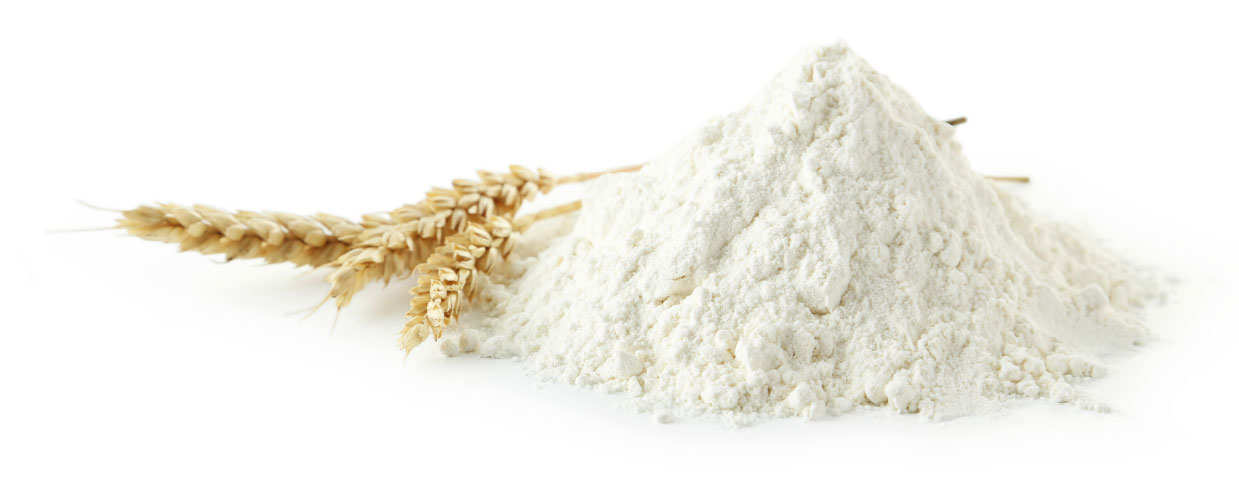
Wheat flour, a powder made from grinding wheat grain, is the most commonly used flour in the world. Without it, there would be no bread, no pastries, and no cakes. And that would be a sad world, indeed.
TYPES OF FLOUR
All-Purpose Flour: This is your go-to flour. If a recipe doesn’t specify what type of flour to use, go with all-purpose. This is usually a blend of hard and soft flours and has a protein content of 11-12%. It can be used in a wide variety of foods, hence its name.
Bread Flour: Made from hard red spring or winter wheat. Has a higher protein content of 12-13%, and is used mainly for breads. The high protein makes baked goods chewier.
Cake Flour: A fine, white flour with a low protein content of 6-8%. It is bleached to create a pure, white color. The bleaching process also allows the cake flour to absorb moisture while developing a weak gluten bond, which promotes tenderness in the final product. Cakes with a high percentage of liquid and sugar need cake flour to rise properly. Besides cakes, this flour can be used for delicate cookies.
Pastry Flour: This low protein flour (8-9%) is usually made from soft red winter wheat. It usually is not bleached, as cake flour is. It is good for pastries (duh!), cookies, biscuits, and pie crusts.
Whole Wheat Flour: This flour has a nutty flavor and is brown in color. It has a high protein content of 11-15% and produces heavier and denser baked goods with less volume. Whole wheat flour is used primarily in breads, but can be used in many other products. Graham flour is a type of whole wheat flour that adds texture and a nutty flavor to baked goods and crackers.
MEASURING FLOUR
The most accurate way to measure flour is by weight:
All-Purpose Flour: 1 cup = 120 grams = 4¼ ounces
Bread Flour: 1 cup = 130 grams = 4½ ounces
Cake Flour: 1 cup = 110 grams = 4 ounces
Pastry Flour: 1 cup = 110 grams = 4 ounces
Whole Wheat Flour: 1 cup = 120 grams = 4¼ ounces
If you don’t have a scale, the best way to measure flour is by lightly spooning the flour into a measuring cup, then sweeping the excess off the top with a straight edge, such as the back of a butter knife. This “spoon and sweep” method ensures that the flour doesn’t get packed down, which would result in a higher volume of flour.
WHAT’S IN FLOUR?
There are a lot of components in flour, but the two most important are starch and protein. Starch makes up 63-77% of the flour, and is responsible for absorbing moisture during baking in a process called gelatinization. Protein accounts for 6-18% of the flour. The proteins glutenin and gliadin make gluten formation possible, which only occurs when moisture is stirred or kneaded in. (We will talk more about gluten formation in another lesson.)
MAKESHIFT CAKE FLOUR
You may have seen before that you can make a cake flour substitute with all-purpose flour and cornstarch. The reason for this is that by adding starch to the flour, you change the ratio of protein to starch in the flour. As we learned above, all-purpose flour has a protein content of 11-12% while cake flour has 6-8% protein. More starch in the flour means a lower percentage of protein. So, while cake flour can never truly be reproduced this way, it will do in a pinch. Just add 20 grams (2 tablespoons) of cornstarch to every 100 grams (¾ cup) of all-purpose flour.
BLEACHED VS. UNBLEACHED FLOUR
Freshly milled flour isn’t ideal for baking. Oxygen helps the flour’s glutenin proteins elongate so baked goods aren’t as sticky or voluminous as they would be with freshly milled flour. The natural oxidation process turns flour white, but bleaching is faster. Unfortunately, bleaching also changes the flavor of the wheat and destroys its natural vitamin E. Unbleached flours go through less chemical processing, and many bakers prefer the flavor. In Europe, there is no bleached flour!
WHAT THE HECK IS MALTED BARLEY FLOUR?
If you flip over your bag of flour, you might find “malted barley flour” is listed as one of the ingredients, alongside wheat flour. Barley, like wheat, is a cereal grain. Malting is when you sprout grains by soaking them, then dry them out. This process creates an enzyme in the barley, called alpha-amylase, which helps starch break down into sugars. Since yeast feeds on sugars, the enzyme in malted barley flour promotes rising in bread dough. I have baked non-bread baked goods with both 100% wheat all-purpose flour and all-purpose flour containing malted barley flour and there was no noticeable difference.
Source: siftandwhisk.com (defunct blog)



























